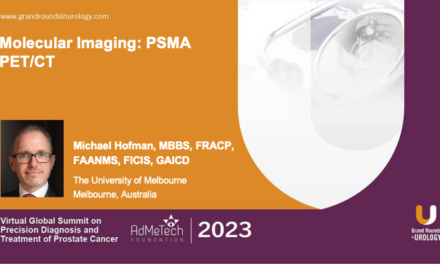Mira Keyes, MD, FRCPC, FABS, presented “ADT and Brachytherapy: The Good, the Bad, and the Ugly” as part of a course on Prostate Brachytherapy released in 2021 and created by the American Brachytherapy Society in partnership with Grand Rounds in Urology.
How to cite: Keyes, Mira. “ADT and Brachytherapy: The Good, the Bad, and the Ugly.” September 2021. Accessed Nov 2025. https://grandroundsinurology.com/adt-and-brachytherapy-the-good-the-bad-and-the-ugly/
ADT and Brachytherapy: The Good, the Bad, and the Ugly
As part of a special course on brachytherapy for prostate cancer from the American Brachytherapy Society and Grand Rounds in Urology, Mira Keyes, MD, FRCPC, FABS, Clinical Professor at the University of British Columbia (UBC) and a radiation oncologist at the Vancouver Centre of the British Columbia Cancer Agency (BCCA), discusses the pros and cons of using androgen-deprivation therapy (ADT) with brachytherapy to treat prostate cancer. After briefly discussing how ADT affects the tumor microenvironment, Dr. Keyes goes over the numerous clinical trials that have investigated how to combine external beam radiation together with hormone therapy. She explains that these trials found that the combination increases overall survival ~10-13% over ADT or EBRT alone, and longer ADT has a greater impact on OS, even with high radiation therapy dose. Dr. Keyes observes that ASCO considers brachytherapy a standard of care and recommends it be combined with ADT for unfavorable intermediate-risk and high-risk disease. She then considers the findings of ASCENDE-RT, the HDR UK trial, and the TROG 0.304 RADAR trial, all of which looked at the combination of ADT and brachytherapy, and discusses several ongoing randomized controlled trials on the role of ADT with prostate brachytherapy. Dr. Keyes also discusses a systematic literature review of ADT + prostate brachytherapy which concludes that the addition of ADT to brachytherapy provides no benefit to cancer-specific survival with ADT, and no benefit to overall survival with ADT, but does provide up to a 15% benefit to biochemical progression-free survival. She also notes that some believe dose escalation (prostate brachytherapy boost) may obviate the need for ADT in some high-risk patients. Dr. Keyes looks at a different meta-analysis which found that the addition of ADT to external beam radiation therapy provided a greater oncologic benefit than a brachytherapy boost and that there was a high probability that intermediate-risk and high-risk prostate cancer treated with EBRT + ADT would have superior overall survival to high-risk patients treated with EBRT + brachytherapy boost. Dr. Keyes argues that this paper misses the fact that the benefit of brachytherapy is that if brachytherapy is used, the duration of ADT can be reduced in unfavorable intermediate-risk and high-risk patients, which has a significant positive impact on quality of life and overall survival. She notes that ADT has numerous negative effects on quality of life, including erectile dysfunction, dementia, osteoporosis, metabolic syndrome, and more. Dr. Keyes particularly focuses on the negative cardiovascular effects from ADT, noting that observational data shows excess cardiovascular morbidity and mortality in patients on ADT with pre-existing cardiovascular disease. She concludes that ADT should be avoided in low- and intermediate-risk prostate cancer patients treated with monotherapy, that ADT for only 12 months in unfavorable intermediate- and high-risk patients is supported by randomized controlled trials, that ADT can be omitted in selected unfavorable intermediate- and high-risk patients, and that shorter ADT duration will improve quality of life and may increase overall survival by decreasing cardiovascular disease morbidity.
For more on brachytherapy, check out the first module of the free Prostate Brachytherapy course from GRU and the American Brachytherapy Society.
ABOUT THE AUTHOR
Mira Keyes, MD, FRCPC, FABS, is a Clinical Professor of Radiation Oncology in the Division of Surgery at the University of British Columbia in Vancouver, Canada. Dr. Keyes' research interests include prostate brachytherapy, genitourinary oncology, and breast cancer.





